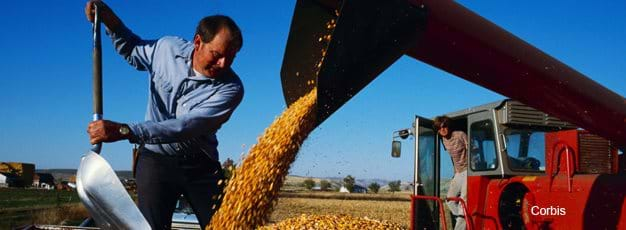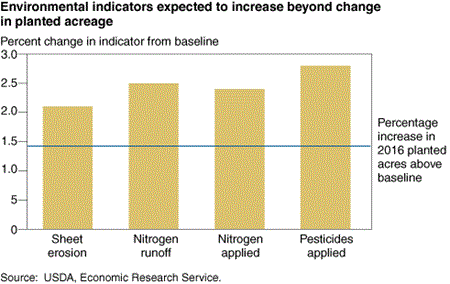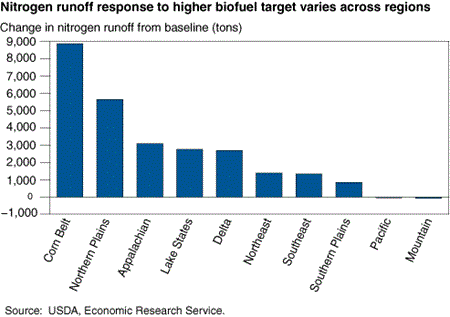Growing Crops for Biofuels Has Spillover Effects

Highlights:
-
Federal mandates for biofuel production promote expanded crop acreage and shifts in cropping patterns and livestock production due to higher prices for corn and other grain crops.
-
An increase in the extent of agricultural land in production and intensity of input use increases the potential for environmental degradation.
-
Research that improves crop productivity and conversion efficiency, as well as conservation practices like no-till and buffer strips, could lessen the environmental impacts of biofuels.
Volatile petroleum prices, along with Federal policies aimed at reducing U.S. dependency on oil imports and mitigating climate change, have sparked rapid growth in biofuel demand. In response, production of agricultural commodities that serve as feedstock for biofuels has increased. Federal policy initiatives and private-sector investment point to continued growth in biofuel production and, consequently, increased demand for agricultural products.
The Energy Independence and Security Act (EISA) of 2007 includes provisions for a Renewable Fuel Standard (RFS) to increase the supply of alternative fuel sources by requiring fuel producers to use at least 36 billion gallons of biofuel by 2022. The RFS provision establishes a level of 15 billion gallons of conventional ethanol by 2015 and at least 21 billion gallons of cellulosic (noncornstarch) ethanol and advanced biofuels (including ethanol from sugarcane and biodiesel) by 2022.
The share of total domestic corn production supplying the ethanol market grew from 7.5 percent in 2001 to 22.6 percent in 2007. The 2007 USDA Agricultural Baseline, which was produced before EISA became law (see “2007 USDA Baseline Provides Projections Through 2016”), assumed that production of corn-based ethanol will reach 12 billion gallons by 2016, or 3 billion gallons below the federally mandated target for that year. By 2016, ethanol production is expected to consume over 35 percent of U.S. corn production. To meet the EISA mandates, ethanol production from cellulosic feedstocks would have to grow from current pilot project levels to roughly 4.25 billion gallons in 2016 and 21 billion gallons in 2022.
ERS used a national agricultural sector model to estimate expected market and environmental outcomes of expanded feedstock production. The model compares the implications of producing 12 billion gallons of corn-based ethanol in 2016 (the 2007 USDA baseline estimate) with production of 15 billion gallons (as reflected in the RFS).
Growing demand for corn and other biomass feedstocks will transform the agricultural landscape as regional cropping patterns adjust and production practices adapt. While biofuels have been viewed as an environmentally preferred alternative to fossil-based fuels, there is growing concern about the potential effects of feedstock development on resource use and environmental quality. By increasing demand for agricultural feedstocks, the new RFS will encourage increased production of crops that may lead to conversion of land for use in crop production, and more intensive use of fertilizers and other inputs, increasing the potential for environmental degradation.
Changes Expected to the Agricultural Landscape
Higher demand for corn, for biofuel as well as for animal feed and human food, has increased corn production in traditional corn-growing regions and elsewhere. As farmers responded to higher corn prices, prices and production levels for other crops adjusted as well. Crop producers have generally benefited from higher returns to corn and other grain crops. Some livestock and poultry producers, however, are worse off. More corn going to biofuels, together with reduced production of soybeans, sorghum, and other feed crops, has contributed to a net increase in grain feed costs for livestock producers. The availability of distillers’ grains, a byproduct of corn-based ethanol production that can be used as a feed supplement for some livestock, may lessen the impact on feed costs (see “Grain Prices Impact Entire Livestock Production Cycle'). These changing feed markets, according to ERS analysis, will prompt a slight decline in animal production.
Given the spillover effects of expanded corn acreage on agricultural markets and the environment, technologies are being developed to produce cellulosic ethanol from a wide range of feedstocks, including crop residues and new crops dedicated to energy production, such as switchgrass. Other potential feedstocks which would not compete for existing cropland—forestry byproducts, municipal solid waste, and even algae—are under development. Since these technologies are not yet commercially operational, corn is likely to remain the major feedstock through the next decade.
Cultivated cropland is expected to expand in all U.S. regions but one, as producers respond to higher crop prices. ERS research suggests that the largest increases in cultivated cropland will likely occur in the traditional corn-producing regions of the Corn Belt (1.6 million more acres in 2016), Northern Plains (1.5 million acres), Delta (540,000 acres), and Lake States (510,000 acres). These estimated changes are conditional on model assumptions regarding corn yield growth, energy costs, ethanol conversion rates, and other factors affecting ethanol productivity and returns.
Corn accounts for roughly three-fourths of the estimated increase in national acreage cultivated under the 2016 baseline case. Corn acres are expected to expand in all regions, with the Corn Belt and Northern Plains showing the largest gains due to comparative advantage in corn production. More farmers are expected to plant corn on a continuous basis, rather than rotating corn with soybeans or other crops. Some of the additional acreage planted to corn and other crops will likely come from land enrolled in USDA’s Conservation Reserve Program (CRP).
| Region | 2016 USDA baseline: total cropland |
2016 USDA baseline: corn acres |
2016 USDA baseline: continuous corn acres1 |
2016 Federal mandate: total cropland |
2016 Federal mandate: corn acres |
2016 Federal mandate: continuous corn acres1 |
|---|---|---|---|---|---|---|
| Appalachian | 18.3 | 4.8 | 1.2 | 18.6 | 5.0 | 1.3 |
| Corn Belt | 101.0 | 44.6 | 8.8 | 102.6 | 45.9 | 9.4 |
| Delta | 15.9 | 0.7 | 0.3 | 16.4 | 0.8 | 0.3 |
| Lake States | 40.0 | 14.5 | 4.3 | 40.5 | 15.1 | 4.8 |
| Mountain | 20.8 | 1.2 | 1.2 | 20.3 | 1.3 | 1.3 |
| Northern Plains | 63.1 | 16.5 | 8.2 | 64.7 | 17.6 | 8.6 |
| Northeast | 15.1 | 3.9 | 2.0 | 15.2 | 4.1 | 2.0 |
| Pacific | 7.7 | 0.3 | 0 | 7.7 | 0.4 | 0 |
| Southeast | 7.5 | 2.3 | 1.1 | 7.6 | 2.4 | 1.1 |
| Southern Plains | 27.6 | 1.1 | 0.5 | 27.7 | 1.2 | 0.5 |
| U.S. | 317.0 | 90.0 | 27.6 | 321.4 | 93.7 | 29.3 |
| 1Acres of cropland planted to corn on a continuous basis, rather than rotating between corn and the planting of other crops, such as soybeans. Source: USDA, Economic Research Service. |
||||||
Land Use and Management Changes Affect Environmental Quality
As more of the Nation’s land is cultivated and as farmers adjust cropping patterns and production practices, the farm sector’s impact on soil and water likely will change. The shift to corn, for example, has largely displaced soybeans and small-grain crops that are generally less input intensive. Higher commodity prices also may intensify use of both irrigation and chemical inputs that enhance crop yield. Much of the new acreage under cultivation may occur on marginal lands that are more highly erodible.
ERS model results indicate that meeting biofuel targets will raise total nitrogen fertilizer use by an estimated 2.0 percent over previous expectations for 2016. Higher fertilizer use reflects increases in both cropland cultivated and intensity of applied fertilizer in corn production (see “Recent Volatility in U.S. Fertilizer Prices”). Nitrogen use rises in all regions except the Delta, where additional soybean acres supplant more fertilizer-intensive crops. The Northern Plains show the largest increase in nitrogen use, reflecting expanded production of corn.
Increases in applied fertilizer may lead to water quality impairment due to nutrient leaching and runoff. Nitrogen and phosphorus runoff from farm fields is a significant source of water pollution throughout the United States. Applied nitrogen on corn fields in the Mississippi River Basin is a primary cause of the oxygen-depleted hypoxic zone in the Gulf of Mexico. The nature and extent of environmental damage from increased fertilizer use will vary depending on farm management practices, soil characteristics, topography, and proximity to water bodies.
While the ERS model cannot predict changes in water quality due to expanded production of corn-based ethanol, results indicate an increase in the amount of nitrogen reaching water bodies under the higher biofuel target. Nitrogen runoff to surface-water bodies in the U.S. is estimated to increase roughly 26,500 tons by 2016, or 2.5 percent above estimated baseline levels. The projected increase in nitrogen runoff is more than proportional to the 1.5-percent increase in U.S. planted acreage, reflecting the shift to corn acreage and additional cropland expansion on marginal land. The change in nitrogen loadings over current levels will likely vary considerably by region, following the pattern of expanded nitrogen use. The Corn Belt, which accounted for 44 percent of nitrogen deposited to surface water from field crop production in 2006, shows an increase in nitrogen runoff of less than 2 percent (8,500 tons) by 2016. In percentage terms, larger increases in nitrogen runoff occur in the Northern Plains, Delta, and Appalachian regions, reflecting expansion in acreage under cultivation.
Water quality is also affected by soil erosion on cultivated cropland. Nationwide, sheet (rainfall) erosion to surface water is expected to rise 2.1 percent by 2016 under the higher biofuel target, with higher increases likely in the Northern Plains, Lake States, and Delta. Wind erosion in the U.S. is primarily concentrated in the Northern Plains, with lesser amounts in the Corn Belt and Southern Plains. Increased erosion reflects increases in cultivated acreage, with potential expansion on marginal croplands. Model results suggest that broader use of soil-conserving tillage systems that minimize soil disturbance at planting time—particularly no-till and reduced-till systems in the Northern Plains and Northeast, and reduced-till in the Corn Belt—may help moderate the net increase in sheet and wind erosion from expanded corn acreage and continuous corn rotations.
Feedstock production for biofuels may involve additional environmental concerns. Greenhouse gas emissions from the U.S. crop sector could increase. Changes in tillage practices and conversion of land to crop production may reduce stored soil carbon. Increased use of nitrogen fertilizers can also increase nitrous oxide emissions (another greenhouse gas). The net effect of biofuels on greenhouse gas emissions is unclear: total emissions could be higher or lower than those associated with carbon-based fuels. A lifecycle analysis, accounting for direct and indirect links along the biofuel production chain, would be needed to fully assess the net effects of biofuels on greenhouse gas emissions. Feedstock production may also increase demands on limited groundwater and surface-water resources. The net effect on agricultural water withdrawals is uncertain, however, and is likely to vary regionally and over time depending on the location of feedstock sources and local production conditions. The demand for corn ethanol would increase water use where corn feedstock production displaces crops that require less water, such as soybeans. Biofuel production could also increase water use due to expansion of irrigated cropland, both through reduced fallow acreage and conversion of nonirrigated crop and pastureland. However, significant expansion in groundwater and surface-water withdrawals may be limited by physical supply availability, legal constraints, and economic considerations.
Land conversion for crop production may also strain local wildlife resources. Converting lands from less intensive uses—including native grasslands, forestland, and cropland set aside for environmental purposes, as through USDA’s CRP—could reduce wildlife habitat and degrade habitat for fish and other aquatic species through increased delivery of sediment, nutrients, and pesticides to water bodies.
Research and Policy Initiatives Can Help Mitigate Environmental Impacts
The demand for corn as a biofuel feedstock has put increasing pressure on land resources and the environment. Research underway to increase ethanol output per acre of corn could help reduce pressure on cropland to meet Federal biofuel mandates. Average U.S. corn yield per harvested acre, based on a projection of historic trends, increases by 1.8 bushels per year under the USDA baseline (170 bushels per acre by 2016). Growth in average yield depends on many factors, including availability of higher yielding varieties, the use of irrigation, and potential expansion in less productive areas. Higher corn yields, as well as new corn cultivars with higher starch content and improved crop-ethanol conversion efficiencies, could reduce the amount of land needed for corn feedstock production. These research-driven gains in productivity also suggest potential improvements in environmental indicators, through both reduced feedstock acreages to meet biofuel mandates and indirect commodity price effects that reduce competition for land.
Cellulosic feedstocks—such as switchgrass, Miscanthus, and poplar—that may be grown commercially on land not currently used for crop production could further relieve pressures on land for food and feed production. Cellulosic feedstocks provide potentially more ethanol per acre of feedstock. Moreover, reduced tillage and input requirements for perennial energy crops may lessen the potential environmental impact of meeting biofuel mandates, with regional effects depending on the allocation of emerging feedstocks. However, significant challenges involving feedstock production practices, transport infrastructure, ethanol conversion technologies, and market formation must be addressed before cellulosic feedstocks become commercially viable.
Crop residues, such as corn stover and wheat straw, may serve as an important source of cellulosic feedstock in meeting mandated targets for biofuel production. Crop residues are already widely available as biomass alternatives to corn feedstock, although significant markets and processing capacity do not currently exist. Moreover, crop residues could provide an additional revenue source for grain producers. Crop residues, however, play an important role in managing soil erosion, nutrient loss, soil carbon, and soil moisture. Thus, residues are not “free”—there is a cost to residue harvesting, and soil productivity and environmental quality may suffer. The amount of residue that can be harvested while maintaining productivity—based in part on the erodibility of the soil and tillage regime used—is an important policy concern and a focus of ongoing research. Research is also needed to determine the environmental effects of large-scale cultivation of dedicated energy crops.
Conservation programs can help mitigate environmental impacts from biofuel feedstock production. USDA’s Environmental Quality Incentives Program provides cost sharing and technical assistance for adoption of conserving practices that improve environmental stewardship. Nutrient and soil management measures could offset potential increases in runoff and leaching under input-intensive corn production. The use of conservation tillage systems, such as no-till, may counteract potential increases in soil erosion. Use of corn stover as a biofuel feedstock would likely promote conservation tillage systems, although guidelines would be needed to ensure sustainable harvest of crop residues. The CRP, which removes environmentally sensitive cropland from production under long-term rental agreements, could also be part of a broader agricultural biofuel strategy. Riparian buffers installed under the CRP Continuous Signup Program may help reduce soil and nutrient runoff from cropland used in feedstock production. USDA conservation compliance provisions, which withhold Federal farm payments to producers converting highly erodible soils or wetlands, may limit corn feedstock production on environmentally sensitive lands. Grazing and haying on CRP land, under an approved conservation plan, can help livestock producers facing high feed costs due in part to biofuel demand. CRP lands could also potentially be used for perennial trees and grasses harvested as biofuel feedstock, if environmental benefits are preserved. Additional research would be needed to assess the potential environmental effects of dedicated energy crops on CRP lands.
<a name='box'></a>2007 USDA Baseline Provides Projections Through 2016
The 2007 USDA baseline provides long-term projections for the agricultural sector through 2016. Projections cover agricultural commodities, agricultural trade, and aggregate indicators of the sector, such as farm income and food prices. The projections are based on specific assumptions regarding macroeconomic conditions, policy, weather, international developments, and yields. The projections assume that there are no shocks due to abnormal weather, outbreaks of plant or animal diseases, or other factors affecting global supply and demand. Government programs that influence agriculture are assumed to remain in effect through the projection period.
Increasing Feedstock Production for Biofuels: Economic Drivers, Environmental Implications and the Role of Research, Biomass Research and Development Board, February 2009



